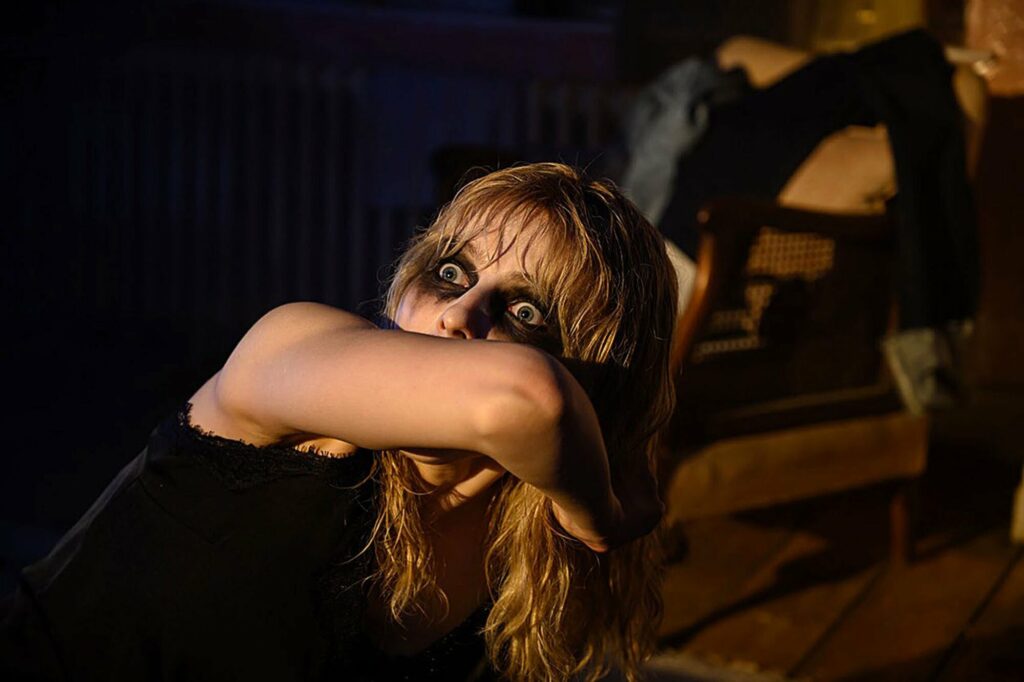Edgar Wright is a self-confessed horror nerd. Three of his most-watched films include Evil Dead II, Carrie and An American Werewolf In London. Elements of the genre have long crept into his work: Shaun Of The Dead is a zombie movie, albeit one where the zombie apocalypse is wrapped up in a rom-com; Hot Fuzz has elements of The Wicker Man, and The World’s End riffs on Invasion Of The Body Snatchers. However, Last Night In Soho feels like Wright’s first out-and-out horror movie, a Giallo-inspired trip down memory lane that descends into madness and murder. Think Midnight In Paris meets Repulsion.

Eloise (Thomasin McKenzie), an aspiring fashion designer in present-day London, is mysteriously able to transport herself to the 1960s where she encounters a dazzling wannabe singer, Sandie (Anya Taylor-Joy). But the era’s glamour is not all it appears to be, and dreams of the past start to crack and splinter into something far darker.
We are introduced to Eloise as she dances along to sixties music in her bedroom. That music is her connection to her mother, who is no longer with her. Music has always been an integral part of Wright’s films, whether it’s used for comedic effect – “Don’t Look Now” in Shaun Of The Dead –, to drive the pace and action in Baby Driver, or a hint at the plot in The World’s End.
Much like film, music has the ability to transport you to another time and place. Quite literally in Eloise’s case, as she drifts off to sleep in her bedsit listening to “Anyone Who Had A Heart“ by Cilla Black and moments later, finds herself in the famous Café de Paris watching the renowned singer perform it live. Only, she isn’t herself. She seems to be viewing events through the eyes of an aspiring young singer, Sandie.

This film’s first trip back in time is a dizzying delight. Wright employs all sorts of old school, practical movie magic tricks such as fake mirrors, twins (James and Oliver Phelps, in a blink-and-you’ll-miss-them cameo), and dazzling choreography to give the impression that Eloise and Sandie are one and the same. This includes a fantastic swinging dance number that sees the two seamlessly swap places in one long tracking shot. What helps to sell the switch in time periods is Taylor-Joy’s presence, whose face seemingly transcends time and space, and looks equally at home in 1630s New England (Robert Eggers‘ The VVitch), 1800s England (Emma), the Swinging Sixties, or the modern day (Thoroughbreds).
Last Night In Soho shares some DNA with another nocturnal nostalgia trip, 2011’s Midnight In Paris. Are these dreams that Eloise is having, or are they echoes from the past? Memories bubbling up to the surface, or literal travel back in time? Unlike Midnight, where the lead character was able to interact with the past, Eloise is only able to watch. Her visions grow darker as Sandie’s dream becomes a nightmare, as her boyfriend-slash-manager Jack (a perfectly charming and sleazy Matt Smith) forces her into a life of prostitution. Helpless to do anything to help in the past, Eloise sets out to solve the mystery of Sandie’s fate in the present. However, opening a door to the past may might have allowed something to come through the other way.
Moving to the bright lights of the big city is often an opportunity for one to reinvent themselves, to become the person they always wanted to be. Eloise dreams of becoming a fashion designer; Sandie dreams of becoming a star. Likewise, Last Night In Soho can be seen as a point of reinvention for Edgar Wright himself.
It’s difficult to know whether this is a compliment or a criticism, but in many ways this feels like the filmmaker’s least “Edgar Wright” film. Sure, there are the odd visual flourishes in Eloise’s initial journey to London (crash zooms, unusual transitions, etc.), and other nods to Wright’s typical stylings, but mostly this film sees Wright move in a new direction. This ode to the ’60s is less informed by his own work than it is drawing on an established visual canon – one that includes works like Suspiria and Peeping Tom, alongside established actors from the period, like Terence Stamp, Margaret Nolan and Rita Tushingham. Meanwhile the late Diana Rigg, who the film is dedicated to, is given a blinder of a final role. She is just wonderful as Ms Collins, the crabby landlady and caretaker to a house full of secrets.

As Eloise’s sanity start to show cracks however, so too does Wright’s film. As the circumstances around Sandie’s fate begin to come into focus, ironically this is where the film loses its own – its attempt to shift the narrative from one of exploitation to empowerment becomes very muddled. It is a bold tactic that employs a few twists along the way, but it’s still not one that sits comfortably with what preceded it, and therefore significantly weakens the overall effect.
Edgar Wright is a filmmaker who is refusing to become stuck in the past. 2021 has seen him release his first documentary, and now throw off the shackles of The Cornetto Trilogy. Last Night In Soho is far from flawless, but it proves a fun and fascinating step forward in Wright’s oeuvre. Much like the fashions of the era, it will likely divide audiences, but who knows? Perhaps we will look back on it in times to come with the same “Golden Age thinking” fondness that Eloise has for the sixties.
Last Night In Soho is in cinemas now.
The film screened as part of the BFI London Film Festival 2021.
